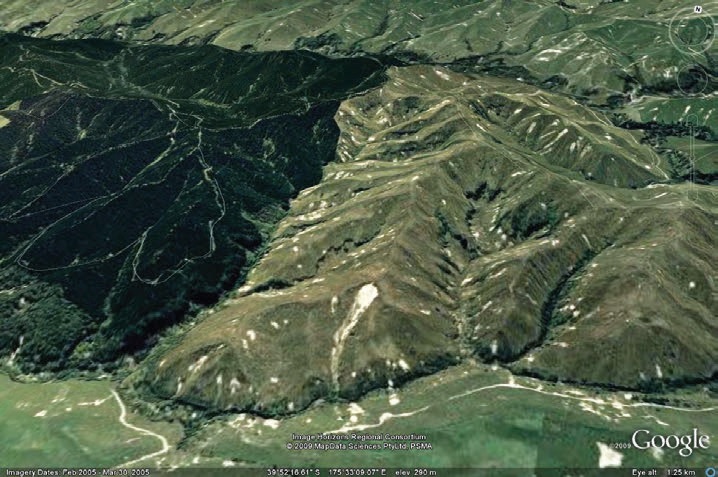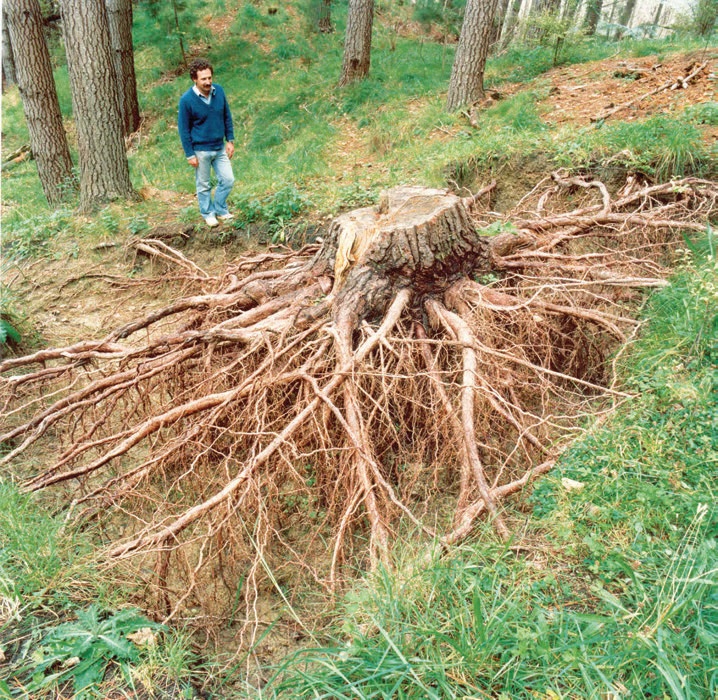Redwoods – what have we been waiting for?
Peter Clinton, Chris Phillips and Russell Coker, New Zealand Tree Grower November 2009.
You may have heard it before − coast redwoods would be great to plant on the eroding soils of New Zealand. This is supported by ability of the species to coppice, its long lived nature and valuable timber. But is this broad statement true? The answer is yes, and perhaps we have known the answer for some time but have tended to ignore it in favour of our focus on radiata pine.
As far back as 1975 a well respected scientist, Rowland Burdon at the FRI wrote an article with the title Is coast redwood an answer to the Mangatu problem? A generation on, Mike Marden, a Landcare Research scientist, described the tolerance of coast redwoods to sedimentation following flooding and land slips. He reiterated that planting redwoods was a possible long term solution to erosion problems on the East Coast.
In addition, some 30 years before Mike’s observations, the prestigious magazine Science published a report of how redwoods were able to develop a second root system adventitiously from their buried stems. This allowed the trees to survive burial in up to nine metres of flood sediments. So here we are one full rotation after the initial suggestion to plant Mangatu and other erodible steep lands in redwoods, and little has happened.
Mangatu represents an example of the eroding land on the East Coast and Wanganui/Manawatu regions that are the current focus of government funded afforestation schemes. The MAF Afforestation Grant Scheme and the East Coast Forestry project both give preference to class VIIe and VIIIe land which has taken the brunt of East Coast erosion for decades. More recently it was the class of land in the Wanganui/Manawatu region devastated by landslips in the storms of 2004.
The role of roots
The role of roots of some tree species in strengthening or reinforcing soil has been well documented. There are now many photograph examples illustrating how land planted with trees fairs better than neighbouring pasture during events such as Cyclone Alison in 1975, Bola in 1981 and other recent rainstorms. If you are a user of Google Earth you can now ‘fly’ the known hot spots and see for yourself the extent of the erosion issue in New Zealand.

The example shown in the illustration on the next page is an area in Manawatu where recently planted pasture was damaged by surface erosion following the storm of 2004. The adjacent forest, only eight years old at the time of the rainfall had protected and reinforced the soil enough to reduce erosion.
As described in the August issue of the Tree Grower, gully erosion is still alive and well on the East Coast.The benefits of tree cover in slowing erosion are well known and supported by research undertaken over a long period of time.
All species should be the same and have roots that spread and which will hold the soil together. But all species are not the same. Each species has a root system architecture that is governed by its genetics as well as conditions in which the tree grows. In terms of soil reinforcement we know that willows and poplars will do the job, radiata pine is good and we should not forget about natives.

Ideal tree
Many tree species have been planted in New Zealand and these have been tried across numerous types of sites. The worst sites such as gullies and earth flows are inherently challenging because of their susceptibility to movement or erosion. Less erosion prone sites usually have more stable subsoils and are subject to periodic rather than continuous movement. If we were able to design a tree specifically to control various erosion processes, what features or attributes would we include in our design specification?
Ideally, the species would have an extensive root system that tolerated wet conditions and burial in aggrading gullies and be capable of regenerating from sprouts or to coppice freely. So far the ideal tree sounds a lot like willow. However, in addition, the ideal tree should also be long lived, have no potential to become a pest and if the timber was of sufficient value it could be partially harvested. These conditions eliminate willow and point to coast redwood.
Not many options
Not many species meet the required specifications for control of erosion processes on all counts. Are there really some species that can combine a range of physiological, ecological and silvicultural attributes that make them outstanding in the field? Can we really match species to sites such as gullies or dry cool sites?
This is one of the fundamental questions being addressed by a new Future Forests Research programme ‘Protecting and Enhancing the Environment through Forestry'. This programme aims to understand the benefits of planted forests not only in terms of timber but more importantly how planted forests contribute valuable environmental services and benefits such as biodiversity, carbon sequestration, recreation, clean water and reduction or prevention of erosion.
Difficult to study
It is fair to say that, to date, we have not extensively researched the root systems of coast redwood here in New Zealand under conditions representative of local soils and climate. Studying the root systems of long lived plant species such as trees is difficult. However the experienced team assembled by the research programme will soon be excavating the root systems of redwoods growing on erodible soils. They will assess the extent and mass of the root systems of young redwoods and obtain information on the rate of expansion of roots of newly planted trees.
We assume that the roots of coast redwood graft and form a continuous live network but we do not know how long this takes. A common observation is that redwoods are slow to establish. Therefore one outcome of this study will be to see if the apparent slowness to establish is due to trees initially allocating greater quantities of carbon to their root systems at the expense of stem growth. These studies will underpin recommendations for species selections for difficult sites, in addition to other studies that researchers at Landcare Research are carrying out.
Soil carbon
Clearly there are other benefits from establishing coast redwoods in addition to the stabilisation of erodible sites, such as the storage of the carbon in their root systems. Forestry in general is therefore a good option for sequestering atmospheric carbon dioxide. However, one issue that is often raised with respect to afforestation is what are the effects on soil carbon?
Soil carbon levels in pastures are artificially high compared to natural or planted forests. Pasture soils have been built up over the years with the use of fertilisers and grazing resulting in the rapid turnover of shallow root systems. However, the levels of soil carbon depend on the fertiliser being applied and the continuation of grazing. Once trees are planted and animals excluded, inputs from pasture roots dwindle, no longer adding to the pools of carbon that are always naturally turning over and then releasing carbon dioxide from the soil.
Carbon storage
In contrast to pastures, less is known about how much tree roots contribute to the long term storage of carbon form the turnover of fine roots and the exudation of carbon- containing compounds which become part of the soil. In the case of redwoods that have been planted for timber production, or specifically for the purpose of erosion control, there are additional benefits in terms of carbon sequestration.
These include the large size the trees can grow to and also the fact that if the trees are harvested, the root systems persist from the sprouting of new shoots. In this way, much less carbon is likely to be lost from decaying root systems as occurs for species such as radiata pine or kanuka. Redwood leaf litter may also contribute to the build up of soil carbon levels beneath the trees.
The prospect of longer rotations with redwoods, or the possibility of planting and leaving this species to obtain the large possible volumes, suggests this species has potential to sequester carbon both in biomass and soil pools. Coast redwoods are a versatile species. If we had listened to the words of Rowland Burdon more than 30 years ago, coast redwoods could have been firmly entrenched in Mangatu forest and beyond.
The change
What has changed in the last 30 years that may change the perception of redwood? Previously, redwood was seen as a long rotation species with wood that was not any better than treated pine or Douglas fir. Now the market for New Zealand grown redwood is not aimed at domestic consumption, and it grows at the same rate as radiata pine so can be harvested at similar rotation lengths. Moreover the value to the grower is greater than either pine or Douglas fir.
Hopefully, the next 30 years will see redwoods planted extensively on the large areas of eroding and erodible soils that New Zealand has. Our research may have provided the necessary information to support its establishment in these environments.
Dr Peter Clinton works for Scion, Dr Chris Phillips works for Landcare Research and Russell Coker works for the New Zealand Redwood Company

 Farm Forestry New Zealand
Farm Forestry New Zealand

